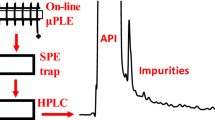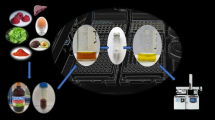Abstract
Herein, a total online device based on field-assisted extraction (FAE), micro-solid-phase extraction (μ-SPE), and high-performance liquid chromatography (HPLC) was designed. Solid samples were pretreated with ultrasound-microwave synergic effects, and then the extract was cleaned up online with a monolithic column, followed by HPLC analysis. The cross-actions between ultrasound and microwave along with other extraction parameters were studied systematically. The efficiency of this online method was verified in the determination of polycyclic aromatic hydrocarbons (PAHs) in foods and tetracycline antibiotics (TCAs) in cosmetic samples. The detection limits of nine PAHs including fluorene, phenanthrene, anthracene, fluoranthene, benzo[k]fluoranthene, benz[a]anthracene, benzo[b]fluoranthene, pyrene, and benzo[a]pyrene were all within 0.075–0.30 μg/kg, as well as four TCAs including oxytetracycline, tetracycline, chlortetracycline, and doxycycline were within 0.02–0.06 μg/kg. Six PAHs were found in roast potatoes and baked fish and the recoveries were in the range of 71.5–119.7% with RSDs of 0.2–10.9% (n = 3). The recoveries for TCAs in cosmetic samples were in the range of 75.3–118.0% with RSDs lower than 8.2% (n = 3). Compared with those offline methods, this total online FAE-μ-SPE-HPLC method not only simplifies the operation process, but also increases the precision and accuracy. Beyond trace analytes analysis in solid and semi-solid matrixes, application of this total online analysis method can also be extended to investigate field-assisted extraction mechanisms.

Graphical abstract





Similar content being viewed by others
References
Clark KD, Zhang C, Anderson JL. Sample preparation for bioanalytical and pharmaceutical analysis. Anal Chem. 2016;88:11262–70.
Perez-Rodriguez M, Pellerano RG, Pezza L, Pezza HR. An overview of the main foodstuff sample preparation technologies for tetracycline residue determination. Talanta. 2018;182:1–21.
Masini JC, Svec F. Porous monoliths for on-line sample preparation: a review. Anal Chim Acta. 2017;984:24–44.
Pan JL, Zhang CJ, Zhang ZM, Li GK. Review of online coupling of sample preparation techniques with liquid chromatography. Anal Chim Acta. 2014;815:1–15.
Bu Y, Feng JJ, Sun M, Zhou CL, Luo CN. Facile and efficient poly(ethylene terephthalate) fibers-in-tube for online solid-phase microextraction towards polycyclic aromatic hydrocarbons. Anal Bioanal Chem. 2016;408:4871–82.
Hyotylainen T. Principles, developments and applications of on-line coupling of extraction with chromatography. J Chromatogr A. 2007;1153:14–28.
Hakova M, Havlikova LC, Chvojka J, Erben J, Solich P, Svec F, et al. A comparison study of nanofiber, microfiber, and new composite nano/microfiber polymers used as sorbents for online solid phase extraction in chromatography system. Anal Chim Acta. 2018;1023:44–52.
Barciela-Alonso MC, Otero-Lavandeira NP, Bermejo-Barrera A. Solid phase extraction using molecular imprinted polymers for phthalate determination in water and wine samples by HPLC-ESI-MS. Microchem J. 2017;132:233–7.
Frizzarin RM, Cabello CP, Barza MD, Portugal LA, Maya F, Cerda V, et al. Submicrometric magnetic nanoporous carbons derived from metal-organic frameworks enabling automated electromagnet-assisted online solid-phase extraction. Anal Chem. 2016;88:6990–5.
Xiao XH, Song W, Wang JY, Li GK. Microwave-assisted extraction performed in low temperature and in vacuo for the extraction of labile compounds in food samples. Anal Chim Acta. 2012;712:85–93.
He YY, Xiao XH, Cheng YY, Li GK. Progress in field-assisted extraction and its application to solid sample analysis. J Sep Sci. 2016;39:177–87.
Cai M, Zhao SN, Liang HH. Mechanisms for the enhancement of ultrafiltration and membrane cleaning by different ultrasonic frequencies. Desalination. 2010;263:133–8.
Hernandez YR, Serrano LAG, Maruri DT, Aparicio ARJ, Diaz BHC, Ocampo MLA. Optimization of the microwave-assisted ethanosolv extraction of lignocellulosic compounds from the bagasse of agave angustifolia haw using the response methodology. J Agric Food Chem. 2018;66:3533–40.
Du YQ, Xia L, Xiao XH, Li GK, Chen XG. A simple one-step ultrasonic-assisted extraction and derivatization method coupling to high-performance liquid chromatography for the determination of ε-aminocaproic acid and amino acids in cosmetics. J Chromatogr A. 2018;1554:37–44.
Pan JL, Huang YC, Liu L, Hu YL, Li GK. A novel fractionized sampling and stacking strategy for online hyphenation of solid-phase-based extraction to ultrahigh performance liquid chromatography for ultrasensitive analysis. J Chromatogr A. 2013;1316:29–36.
Zhou T, Xiao XH, Li GK. Hybrid field-assisted solid-liquid-solid dispersive extraction for the determination of organochlorine pesticides in tobacco with gas chromatography. Anal Chem. 2012;84:420–7.
Wuethrich A, Haddad PR, Quirino JP. The electric field - an emerging driver in sample preparation. TrAC-Trends Anal Chem. 2016;80:604–11.
Zhang QC, Cheng YY, Li GK, Xiao XH. Porous boronate affinity monolith for on-line extraction coupled to high-performance liquid chromatography for sensitive analysis of heterocyclic aromatic amines in food samples. Chin Chem Lett. 2015;26:1470–7.
Mishra RR, Sharma AK. Microwave–material interaction phenomena: heating mechanisms, challenges and opportunities in material processing. Compos Part A-Appl S. 2016;81:78–97.
Saleh IA, Vinatoru M, Mason TJ, Abdel-Azim NS, Aboutabl EA, Hammouda FM. A possible general mechanism for ultrasound-assisted extraction (UAE) suggested from the results of UAE of chlorogenic acid from Cynara scolymus L. (artichoke) leaves. Ultrason Sonochem. 2016;31:330–6.
Ramalhosa MJ, Paiga P, Morais S, Delerue-Matos C, Oliveira MB. Analysis of polycyclic aromatic hydrocarbons in fish: evaluation of a quick, easy, cheap, effective, rugged, and safe extraction method. J Sep Sci. 2009;32:3529–353.
Zhang LT, Huang SY, Yang X, Lu YN. Determination of six kinds of antibiotics and metronidazole in anti-acne cosmetics by high performance liquid chromatography. Chin J Anal Lab. 2015;34:1403–7.
Guan JJ, Zhang TB, Hui M, Yin HC, Qiu AY, Liu XY. Mechanism of microwave accelerated soy protein isolate-saccharide graft reactions. Food Res Int. 2011;44:2647–54.
Miano AC, Ibarz A, Augusto PED. Mechanisms for improving mass transfer in food with ultrasound technology: describing the phenomena in two model cases. Ultrason Sonochem. 2016;29:413–9.
Andrade-Eiroa A, Canle M, Leroy-Cancellieri V, Cerda V. Solid-phase extraction of organic compounds: a critical review (part I). TrAC-Trends Anal. Chem. 2016;80:641–54.
Andrade-Eiroa A, Canle M, Leroy-Cancellieri V, Cerda V. Solid-phase extraction of organic compounds: a critical review. TrAC-Trends Anal Chem. 2016;80:655–67.
Funding
This work was supported by the National Natural Science Foundation of China (nos. 21675179, 21675178, 21874159, and 21804147), the Special Funds for Public Welfare Research and Capacity Building in Guangdong Province of China (no. 2015A030401036), and the Guangzhou Science and Technology Program of China (no. 201604020165).
Author information
Authors and Affiliations
Corresponding authors
Ethics declarations
Conflict of interest
The authors declare that they have no conflict of interest.
Additional information
Published in the topical collection New Insights into Analytical Science in China with guest editors Lihua Zhang, Hua Cui, and Qiankun Zhuang.
Publisher’s note
Springer Nature remains neutral with regard to jurisdictional claims in published maps and institutional affiliations.
Electronic supplementary material
ESM 1
(PDF 5.84 kb)
Rights and permissions
About this article
Cite this article
Xia, L., He, Y., Xiao, X. et al. An online field-assisted micro-solid-phase extraction device coupled with high-performance liquid chromatography for the direct analysis of solid samples. Anal Bioanal Chem 411, 4073–4084 (2019). https://doi.org/10.1007/s00216-019-01809-y
Received:
Revised:
Accepted:
Published:
Issue Date:
DOI: https://doi.org/10.1007/s00216-019-01809-y




